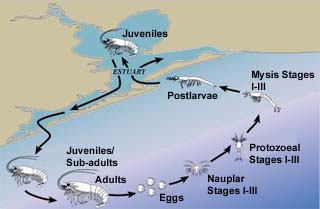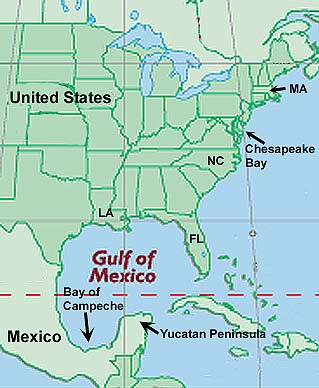|
|
Penaeus aztecus (Brown), Penaeus setiferus (White), and Penaeus duorarum (Pink) are the three shrimp species most commonly harvested by North Carolina commercial fishermen.
All three species of shrimp are spawned in the Atlantic Ocean, but rely on estuaries during their juvenile stages for protection and nutrients. They are transported seasonally into shallow water regions of the estuaries (usually bays and tributaries) via tides and currents, and remain in these "nurseries" until they develop into mature adults.
In North Carolina, these shallow waters are designated as Special Nursery Areas, and are protected from all trawls for marine fishing. Once the shrimps are mature, they leave the estuaries to spawn, and it is at this time that they are most vulnerable to harvesting.
(NMFS, 1998; Norman 2003b; www.ncfish.org/aboutindustry.htm; www.ncfisheries.net/; zooplankton.lsu.edu/history.htm)
|
|
Brown, white, and pink are found all along the western Atlantic coast from Maine, U.S. to the Yucatan Peninsula, Mexico.
- Penaeus aztecus. Brown shrimp occur along the Western Atlantic coast from approximately Martha’s Vineyard, MA through Florida and the Gulf of Mexico to the lower Yucatan Peninsula.
- Penaeus setiferus. White shrimp are known from Fire Island, New York south to St. Lucie Inlet, Florida. The range then extends around the Florida Peninsula into the Gulf of Mexico from the Ochlocknee River in northwest Florida to Campeche, Mexico. Several centers of abundance have been identified for P. setiferus. Primary among them is coastal Louisiana around the Mississippi River Delta. Other abundance areas occur in northeast Florida, Georgia, and the region around the Bay of Campeche, Mexico.
- Penaeus duorarum. Pink shrimp occurs in coastal waters and estuaries from the region around Chesapeake Bay south through the Florida Straits and the Gulf of Mexico to Cape Catoche and Isla Mujeres on the tip of the Yucatan Peninsula.
(www.sms.si.edu/irlspec/Pspecies1.htm; www.worldatlas.com/webimage/countrys/na.htm)
Figure 3 is a graph of the total weight of shrimps landed by commercial fishermen in North Carolina from 1972 to 2002. Use this data as a preliminary indication of the shrimp population in NC. The graph suggests that the population fluctuates regularly. Nonetheless, stock status for shrimp is considered viable.
|
Shrimp harvesting equipment has evolved over time from cast nets and haul seines by hand to today's preferred mode of commercial shrimp harvest via diesel powered vessels equipped with up to four trawl nets, pulling up to two at a time. Shrimping vessels pull otter trawls (Figure 4) or Mongoose trawls, which are otter trawls modified with a baseball cap bill-like structure across the top of the trawl mouth. This modification prevents shrimp that swim up the water column when disturbed from escaping the forward moving net.
Trawls are non-selective collecting gears , which means anything within the path of the trawl net as it is pulled is subject to be gathered in the net. However, trawl net dimensions are federally regulated.
Currently, North Carolina is the only state on the U.S. Atlantic coast that allows shrimp trawling to take place in its estuarine waters.
(Allegood, 1998; NMFS, 1998; National Research Council 2002; galveston.ssp.nmfs.gov/shrimpfishery/history.htm)
|
The indiscriminate harvesting by trawls is the cause of primary concern to fisheries managers and conservationists because the incidental take of commercially valuable fish and non-target animals (including federally endangered and threatened sea turtles) is extremely high. The National Marine Fisheries Service reported that less than one-fifth of all tows during the 1992-1996 sampling periods resulted in commercially valuable catch for the shrimp industry. The remaining 54% finfish and 31% other crustaceans, which include blue crabs.
The dragging of the heavy ground rope, tickler chain, and filled cod end of the trawl net all contribute to the disruption and habitat destruction of the sea bottom, and is another source of conservation concern.
(NMFS 1998; Watling and Norse 1998)
- How can shrimp trawling affect blue crab population?
This web site was created by Lynn Tran at the North Carolina State University, Department of Mathematics, Science, and Technology Education on 7/12/03. Faculty advisor Dr. David Eggleston, NCSU, Department of Marine, Earth, & Atmospheric Sciences. Last updated December 29, 2003 .



